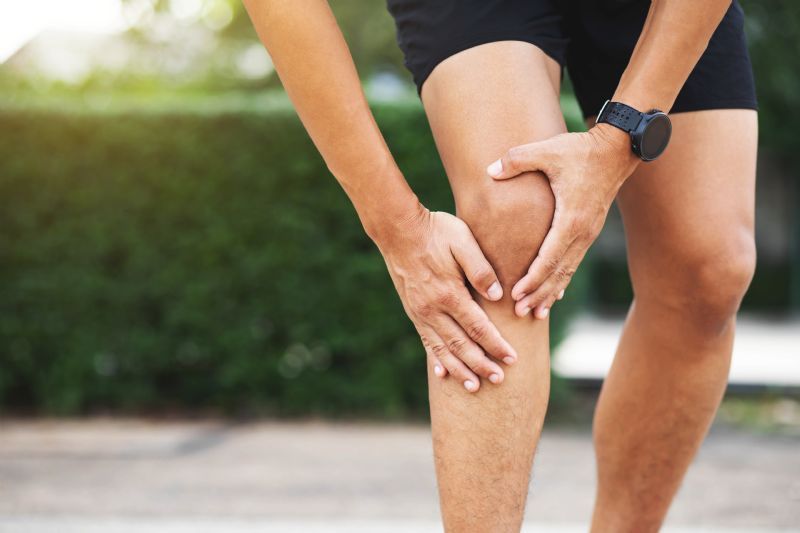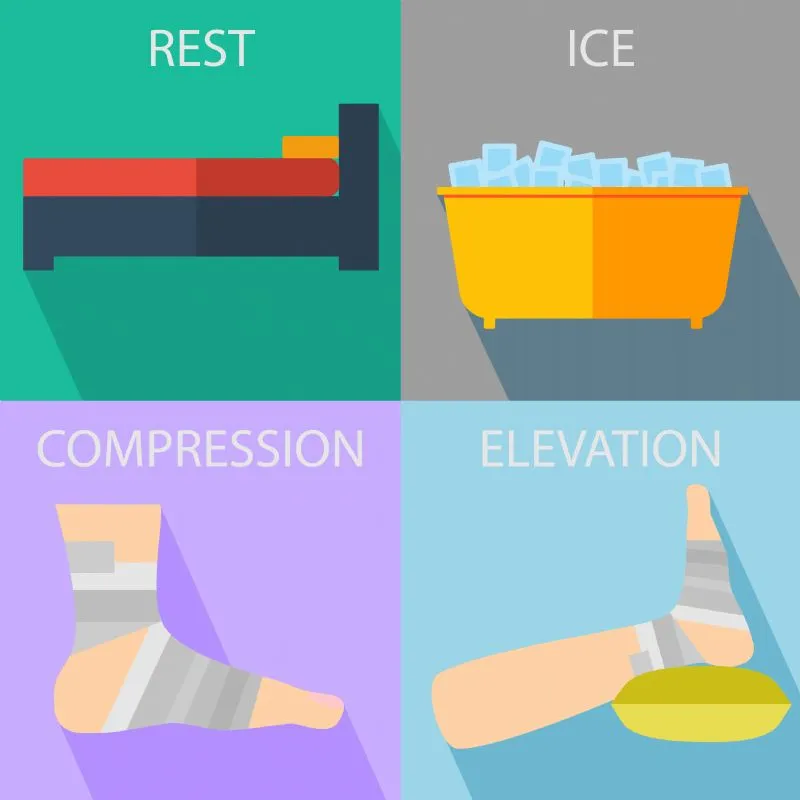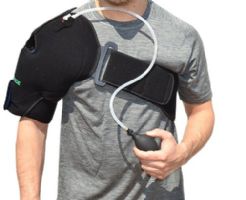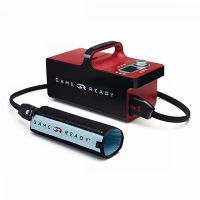 Written by Hulet Smith, OT
Written by Hulet Smith, OT
Have you ever had long-lasting pain from an injury that nagged at you long after the moment you were injured? This is a common experience, and a new remedy for that nagging pain is becoming more and more popular, and for good reason: cold compression therapy.
This form of therapy uses pressure against the muscles combined with cold temperatures to provide a number of meaningful benefits that can be a huge blessing to you during your injury recovery period and beyond. Best of all, this form of therapy is accessible to all from the comfort of your home, using products that are effective and easy to understand.
Read on to discover how you can reap the benefits of cold compression therapy yourself!
Historically, cold compression machines have been used for sports medicine purposes. Cold compression machines are very popular among professional athletic trainers, sports medicine physicians, and physical therapists.
However, this innovative therapy modality can be utilized by so many more people! These machines can help people of all shapes, sizes, ages, and abilities to better recover from both short and long-term injuries. Nowadays, it is common to see regular folks use a cold compression machine.
Cold compression machines are used to rehab an injury, recover from surgery, general pain relief, and/or soothe injured muscles. Anyone from professional athletes to seniors can utilize this type of therapy.

RICE is a popular mnemonic taught to help students remember their first aid basics for treating an acute soft tissue injury. The acronym stands for Rest, Ice, Compression, Elevation and sometimes includes the addition of a 'P' at the beginning which refers stands for 'Protect the area.'
This advice is not only given for acute injuries, but is also recommended by orthopedic surgeons following surgical procedures to aid in healing and recovery.
Traditionally, this advice would be followed by elevating the affected area, usually a limb, placing a cold compact on the injury, and wrapping it in an athletic tape or bandage of some type. Cold compression therapy takes this process to the next level by combining cold and compression in a dynamic process that actively pumps away edema and stimulates fresh blood flow to soothe away pain and encourage healing.
When swelling is left unchecked, it can sometimes cause a secondary injury due to the lack of freshly oxygenated blood to the area. Cold and compression is the best way to stave this off, reducing swelling and stimulating blood flow. Additionally, the sooner that cold and compression can be applied after an injury occurs, the better that blood flow can be controlled, resulting in less inflammation and pain as well as quicker recovery times.

Medical, sports, and rehabilitation experts agree that cold therapy combined with compression therapy is one of the best treatments for musculoskeletal pain, injury, and inflammation. Cold compression therapy can provide a variety of benefits that help speed healing and improve feelings of pain and swelling.
While all forms of cold compression therapy will help reduce inflammation and stimulate healing, there are several different types of wraps and equipment available, with each designed specifically to cater towards unique needs in professional, athletic, and residential applications.
Cold compression therapy machines typically utilize either static, dynamic, or intermittent.
Available in multiple shapes and styles, wearable cold compression wraps are specifically designed to provide stay-in-place therapy. Most provide adjustable static compression benefits, and come with a variety of gel packs that are either kept in the freezer or create a non-toxic chemical freeze when activated. Some devices offer secured and ergonomic holders for ice and cold water.
They are configured for every part of the body, and will stay in place on the shoulder, neck, various parts of the back, elbow, wrist, knee, ankle, and foot. With their comfortable, firm, and consistent pressure, Ice20’s extensive line of wearable cold compression wraps provide exceptional therapy, and their no-leak, refillable ice bags are convenient and easy to use.
 | Hot and Cold Therapy Shoulder Wrap with Double No-Leak Bags - ICE20 View Product |
Combining the convenience of wearable therapy with dynamic cold compression, some compressive cold devices offer the best of both worlds, especially for users who need to stay active. Active compression designs like those offered by G-Force allow wearers to adjust the pressure up or down with the easy-to-use pneumatic bulb. The reusable, re-freezable gel packs provide efficient cold therapy to reduce inflammation, pain, and swelling, while the constantly-adjustable compression further enhances this process, resulting in faster relief and healing.
The convenience and versatility provided by wearable dynamic cold compression allow users to get on with other activities and daily living tasks, all while receiving hassle-free and comfortable healing therapy. The dynamic wraps are designed to stay in place for all different parts of the body, such as the knee, shoulder, and lower back.
 | Ice and Compression Therapy Shoulder Brace - G-Force View Product |
Often utilized in professional therapy, athletic, and medical settings, intermittent pneumatic compression (IPC) devices provide controllable, dynamic compression and temperature modulation to treat a wide variety of patients with injuries. Although they all work a little bit differently offering various forms of cold compression, IPC machines are typically designed to treat a patient who is sitting or lying down, with a specified program and time suited for each individual.
As a versatile and effective form of dynamic intermittent pneumatic cold compression, the Squid Cold and Compression Therapy Unit delivers effective cold compression deep into the injured body areas, resulting in immediate pain and swelling relief. With its comprehensive selection of disparate body part wraps and sizes, this multi-chambered system offers adjustable programming for sequential intermittent compression and temperature control to treat a vast array of patients. It provides an effective and economical alternative to older and clunkier clinical cryotherapy equipment, and offers the convenience and versatility of being portable, as well.
 | Cold Compression Unit for Shoulders - Squid Go View Product |
Another outstanding innovator in the dynamic cold compression field is Game Ready. As one of the most trusted voices in physical therapy, Game Ready offers cutting-edge physical therapy systems created by CoolSystems, Incorporated. Their patented technologies provide therapy with new and inventive methods, and have become the gold standard their competitors aspire to meet. Their Med4 EliteMulti-Modality Therapy System not only provides the utmost in intermittent pneumatic compression, but also offers cryotherapy, rapid contrast therapy (RCT), and thermotherapy all in one amazing, compact device.
 | Hot and Cold Multi-Modality Therapy System - Game Ready Med4 View Product |
Specifically designed to improve rehabilitation and treatment outcomes, this combination treatment equipment helps to control swelling, reduce pain (and nerve pain), improve range of motion, enhance circulation, and accelerate the healing process. Their dual-action ATX wraps divide water and air circulation into two separate compartments, resulting in maximum skin contact and heightened circulation in and out of the damaged tissues.
Their proprietary ACCEL (Active Compression and Cold Exchange Loop), used in their Pro 2.1 Cold Compression Therapy Unit manages the functions of the wraps connected to that unit, or the Med4 Elite unit, which are available for every part of the body. The unparalleled dynamic compressive cryotherapy provided by Game Ready’s professional equipment offers medical professionals the best methodology to reduce pain and swelling from their patients’ injuries, along with faster healing and recovery times.
 | Ice Therapy Machine Unit for Cold and Compression Therapy with Optional Wraps - GRPRO 2.1 by Game Ready View Product |
It is important to note that while cold compression therapy when properly applied is safe for most people, there are certain contraindications to be aware of with other existing conditions.
If you have a hypersensitivity to cold temperatures or desensitivity that makes you unable to perceive temperatures, cold compression therapy may not be right for you. It is not recommended for anyone with Raynaud’s Phenomenon, cold urticaria, cold erythema, or cold hemoglobinuria.
If you’re unsure about your risks and benefits, please consult a licensed healthcare professional before using any form of cold compression.
Combining very cold temperatures with either static or dynamic compression helps reduce pain and swelling in injuries like sprains, strains, tears, and anything that causes swelling and inflammation. The cold temperatures temporarily restrict blood flow to the injured area by narrowing the blood vessels, while the compression reduces swelling by pumping built-up fluids away from the site.
Cold compression therapy can be used to help calm muscle spasms, minimize bruising, and soothe nerve endings, encouraging quick and effective healing for a variety of muscle, tendon, and ligament injuries. This unique therapy is available to you in several different forms, each designed to suit a variety of needs ranging from professional therapy, sports, and medical applications through personal first aid to use at home.
As you can see, there are a lot of options when it comes to cold compression therapy, and all of them are effective at healing and combating pain in different ways. When you’re dealing with an injury, your ability to recover quickly and effectively is paramount, and cold compression therapy can definitely help with that. Don’t miss out on this highly beneficial modality!
As always, thanks for reading, and keep an eye out for similarly illuminating articles on our Caregiver University platform. Have a great day!

Co-founder/CEO of Rehabmart, Pediatric Occupational Therapist, husband, and father. Passionate about connecting special needs kids with superb nutrition, sensory integration, and complementary health strategies. Excited about Rehabmart's mission to become the premier online educational platform which empowers caregivers by spotlighting innovative devices and interventions to achieve optimal patient response and recovery.
 Ice Therapy Machine Unit for Cold and Compression Therapy with Optional Wraps - GRPRO 2.1 by Game Ready
Ice Therapy Machine Unit for Cold and Compression Therapy with Optional Wraps - GRPRO 2.1 by Game Ready
 Ice Therapy Machine Unit for Cold Therapy Treatment with Self Regulating Temperature System - CoolJet
Ice Therapy Machine Unit for Cold Therapy Treatment with Self Regulating Temperature System - CoolJet
 Ice Therapy Machine Rolling Storage Cart with Drying Racks for Hausmann Game Ready Systems
Ice Therapy Machine Rolling Storage Cart with Drying Racks for Hausmann Game Ready Systems